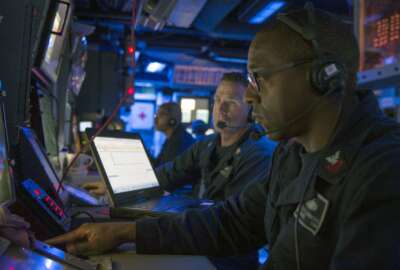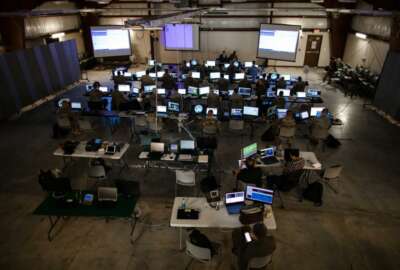
The Defense Industrial Base has some glaring flaws
For the first time ever, the National Defense Industrial Association, along with help from the data analytics firm Govini, took a look at the health of the Defense...
Best listening experience is on Chrome, Firefox or Safari. Subscribe to Federal Drive’s daily audio interviews on Apple Podcasts or PodcastOne.
For the first time ever, the National Defense Industrial Association, along with help from the data analytics firm Govini, took a look at the health of the Defense Industrial Base. It showed many strengths but also some glaring flaws, earning the DIB a C grade. To explain some of the findings, Federal Drive with Tom Temin’s Eric White spoke with Hawk Carlisle, President and CEO of NDIA, along with Wes Hallman, NDIA’s Senior VP for Strategy and Policy.
Interview Transcript:
Hawk Carlisle: There was an executive order, 13806. That was a study of the industrial base in the United States. So the 13806 report came out, and then, Wes and I had spent a period of time on The Hill and actually, we talked to some of the staff directors from the Big Four committees and they had referenced, you know, we talked about the challenges based on the 13806 report that was still in the process, hadn’t actually finished, but some of the staff directors had referenced that, “Hey, you know, the Heritage Foundation puts out a report yearly on the strength of the U. S. Military, based on data analytics and how they look at things. And they said, “What would be incredibly valuable to us would be the same thing for the defense industrial base so we would have an idea of DPA, Defense Production Act, Title I and Title III money or different things that they could do to support the defense industrial base as part of national security. So I think it was a combination of all those things. And it’s incredibly important if you look at the NDS, which is another part of great power competition, and what our nation has done for the last 20 years in fighting violent extremists. All of it kind of came together: 13806, talked with folks on The Hill, and then the National Defense Strategy all kind of came out and we said, “Hey, this is exactly in our wheelhouse, what we need to be doing as the largest and most well-known defense industrial association. And so we took it on, and actually we think it’s incredibly important as we move forward.
Eric White: Wes, what are you hearing from policy writers as far as how they’re going to utilize this information and how it’s really an advantage for them to know this kind of stuff?
Wes Hallman: I think the question is a very good one, and it gets to the heart of the reason for the report and how we did it. Like General Carlisle said, this is a data-driven report. Our goal in this was to make some conclusions, but not necessarily to make some upfront recommendations out of those conclusions. So this could be seen as a reference for not just NDIA and its members and our efforts on behalf of the health of the defense industrial base, but also other thought leaders in the community so they could look at this and could set a baseline for a discussion. And what we’ve seen since the release of this is several op-eds and other media presentations where this has been picked up, talked about and referenced and, really, it’s doing what we hoped, which was to begin that discussion on the health of the defense industrial base, because this is a thing that needs to be invested in over time for it to be there, not just on behalf of the warfighters but on behalf of the nation when when we need it. And frankly, like General Carlisle said, the new National Defense Strategy highlights that we’re in an era of great power competition, and when you require those very high-end capabilities, you have to have a defense base and the innovation within that defense industrial base to provide for the warfighter to maintain the capability gaps that we’ve enjoyed over decades and have actually closed down a bit over the last couple of decades. And we need to reinvest in this defense industrial base. And to have a report like this that identifies some aspects of what’s going on and where we need to focus attention, I think, is valuable.
Eric White: We’re speaking with retired General Hawk Carlisle. He is the president and CEO of the National Defense Industrial Association. Retired Colonel Wesley Hallman is senior vice president of strategy and policy for the NDIA. And so let’s go through the report. We can get kind of a CliffsNotes version of this, though, but why don’t we just start out with some of the general takeaways that you all saw? Wes, you want to start off?
Wes Hallman: Sure. I think one of the greatest takeaways is that, overall, we still have a very strong, innovative defense industrial base that is still the best of the best. But what we see is challenges that have happened over the last few decades, one of those being budget instability and changes in strategic direction that have not indicated to industries what to invest in over time. We’ve seen an increasingly out-in-the-open competitor, especially in China, that is looking to pilfer what they can, steal what they can, copy what they can, and innovate where they can to challenge our advantages across the spectrum. And then I think that you also see some challenges on what we call the input conditions. And I would especially point to our workforce challenges over time. So those are some of the big takeaways. But I think that you can also see that some of the things that have happened in recent years to both define what our National Defense Strategy is and then to invest in that, you see some positives in the report from those investments, and we’re looking to see what that does over time.
Eric White: Hawk, your thoughts?
Hawk Carlisle: No, I agree. I think Wes and his team did great work in this, and I think you got that right. I think there’s limitations. We know the cybersecurity and obviously the growth of the cyber threats has been exponential over time. So that’s a big one, and frankly, you’ve got to give DoD a whole bunch of credit and the Cybersecurity Maturity Model Certification–CMMC–and what they’re doing and what companies are doing, and what commercial enterprises–you look at the banking industry and how seriously they’ve taken that. But that’s a challenge, so that is a threat and that score was low. But you would have expected it to be low because it’s emerging and we’re just now getting ahead of it and starting to address it, I think, with what’s coming out from DoD and CMMC.
Eric White: The Pentagon recently took over the security clearance process. That is an area that was sort of flagged in the report as being an area for improvement. How do you see that improving as DoD takes the reins on it as we have seen that, since then, there has been a decline in the backlog?
Hawk Carlisle: Yeah, that was a challenge to get it factually right. It was run by OPM for a long time. It wasn’t in DoD. It was in the Office of Personnel Management, OPM, and in fact, it was a challenge. Again, it kind of goes back to where the focus was for the last two decades in countering violent extremism. I think that we had not modernized the process. We hadn’t put the technology in place, and it was becoming very critical to both the Department of Defense as well as to some other agencies, the Director of National Intelligence as well. But also, what was less realized, was it’s a huge factor to industry, because industry had to have clearances to work on programs and they had to bring that workforce in and get them clearances. So I think you spend 90% of your time studying the problem and figuring out what’s wrong, and then fix it, and the next 10%, I think, they have moved it out of OPM and moved it back into DoD. They have done a good job in putting technology in place and modernizing the process. I will tell you, I for one, in my clearance, I’m now on what’s called continuous monitoring, which means we don’t have to do the–every five years, you have to have this re-investigation that there’s factors that they look at, and they continually look at them and if a couple of them change, then they go, “Hey, we need to take account of this if everything pretty much stays the same and so there’s new technology and modernization in the security clearance process.” It’s having a positive effect. We’ve cut the backlog. We got more work to do, but I think DoD is moving in the right direction.
Copyright © 2025 Federal News Network. All rights reserved. This website is not intended for users located within the European Economic Area.
Related Stories





